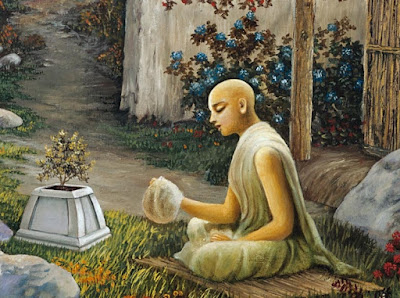Q: I have been reading your “A Simple Gita” and there are many things I like about it. For example, the very clear and modern language, which makes me think about what Krishna says in a slightly different way, which makes the message sink in better.
For example, I like how you have replaced the word “lust” with “selfishness” in chapter three. Of course both words are useful. “Lust” connotes the strong desire for sense objects. “Selfishness” is more general and explains a bit less of the mechanics, but is a term much more widely understood.
A: Thank you!
The term in chapter three is काम (kāma) which is one of the four goals of life, indicating happiness or pleasure, but as it is used in this content, a negative context, it refers to selfish conceptions of pleasure. Kāma (“lust”) is actually defined as a selfish conception of pleasure.
ātmendriya-prīti-vāñchā — tāre bali ‘kāma’
“Kāma” is known as self-centered desire”
Śrī Caitanya-caritāmṛta, ādi-līlā, 4.165
Q: However, I don’t know why you use the word “nirvana” in several places. For example in verse 2.72, in fact Krishna uses the word “brahma-nirvanam”, which Prabhupada translates as “the spiritual kingdom of God”. You translate it as “the supreme spiritual peace (nirvana).”
A: I think you’ve answered the question yourself. I use the word nirvana where Krishna uses the word nirvana.
Q: Also, you translate 4.35: “You will see that all living beings are within you, and that you are within me.” Whereas Prabhupada translates: “…you will see that all living beings are but part of the Supreme, or, in other words, that they are Mine.” All living beings are within Arjuna?
A: 4.35 says: येन भूतान्यशेषाणि द्रक्ष्यस्यात्मन्यथो मयि – yena bhūtāny aśeṣāṇi drakṣyasy ātmany atho mayi
The word yena refers to the subject Krishna was discussing, knowledge.
Bhūtāni aśeṣāni means “in endless creatures” / “in all living beings.”
Drakṣyasi means to see.
ātmani means “in the self.”
So bhūtāny aśeṣāni drakṣyasy ātmani means “seeing all creatures within yourself.” It means seeing unity with all creatures. Seeing every creature as we see our own self. Seeing no divisions between oneself and others.
Then the line conclues, atho mayi.
Athaḥ means “then” or “thus”
Mayi means “in me”
So this means that by seeing the self within all creatures, we will see Krishna everywhere.
The fuller meaning is that all there entities, Arjuna/the self (ātma), Krishna/God (“mayi”) and all creatures (“bhūtāny aśeṣāni”) are all unified, and one sees all three in all three.
It’s quite difficult to express it succinctly in English. In the next revision of A Simple Gītā, I will look at this verse carefully again and see if I can make the English include more of the full meaning, without rambling on too much.
Tagged:
a simple gita,
Bhagavad Gita,
Bhagavadgita 

































